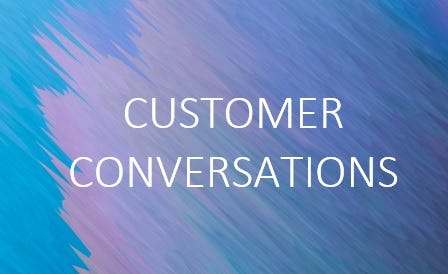Prioritizing Customer Conversations in Your Workweek
Moving from busy to customer-centric
Product leaders crave customer feedback to provide the best product experience to their customers. How do you squeeze meaningful customer conversations into your busy work week?
Compelling Questions
Driving to meaningful customer conversations takes a bit of thought and preparation. For example, a few customers have asked about a major product change such as automatic software updates. How can you get meaningful information about this request from your customers?
Start with a list of compelling questions for discussion. Customers who want to influence your product direction will respond well to open-ended questions. Seeing that you are giving serious consideration to their requests demonstrates that you plan to take action to provide product improvements that save their time.
For a major change such as automatic updates, some examples of compelling questions would be:
What prompted this request in your organization?
In what ways will automatic software updates save time in your organization?
Can you walk through an example of how you do updates with the current product?
Next, prepare a list of customers to contact about these questions.
Finding the Customers
There are two ways to find customers for meaningful conversations:
Pull from your customer list based on key characteristics.
Provide the key characteristics to your product’s sales team to find customers for your conversation
In both cases, you prepare a list of customer characteristics. Some typical customer characteristics for a meaningful conversation are:
Customer segment by size of customer or products used
Role or title of the customer contact
Geographic location of the customer
Purchase history
Feature usage
Feature requests
The customer’s estimated annual budget
If you want a deeper dive into compiling customer conversations and presenting your findings to stakeholders, then my whitepaper on 5 Steps to Meaningful Customer Conversations will come in handy.
With the characteristics of your ideal customer for your compelling questions, then you can start building a list of customers.
Pull from your customer list
Using the customer characteristics, you can create a database query and a list of customers. Be sure only to contact customers who have indicated contact is allowed.
Next contact the sales lead for each potential customer and check if there are any customers that should not be contacted. For example, if the customer is in the middle of a re-org, then the timing of your questions might be bad.
Then email the customer contacts with an overview of the questions and tell them the benefits of speaking with you. Make it easy to say YES to your request!
The sales team finds your customer list
Using the customer characteristics, contact your sales team to find customer contacts that fit your characteristics. When contacting the sales teams about customer contacts, give the sales teams an easy way to contact their customers with your request.
Before contacting your sales team, prepare a short email request to them:
Why you want a customer conversation and how this conversation will make the product better for customers
Summary of your ideal customer characteristics
An email attachment for each potential customer that gives an overview of the questions and the benefits of speaking with you.
Then send an email to your sales team.
In both cases, communicate your deadline for their feedback to be considered for your next product iteration.
Conclusion
It is important to engage with customers for meaningful conversations - even when there are many demands on your time. Using these steps can save time and get valuable information from your customers:
Prepare 3-5 compelling questions
Find customers that meet your characteristics
Hold the conversations
After repeating this process, you learn more about your customers each time.
Link of the Week
A Guide on Talking to Customers from Charlie at IdeaHub. This article from a B2B SaaS product manager covers ways to collect feedback, which customers to listen to, and what kinds of questions to ask. Plus a few extra links about interviewing customers.



That’s a good starting point. I suggest people reserve time in their calendars to actually to speak to users, otherwise their will always be other important things to do.
And don’t forget to speak to users who are not yet your customers as well!